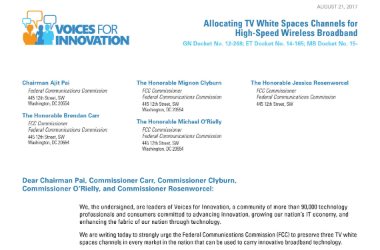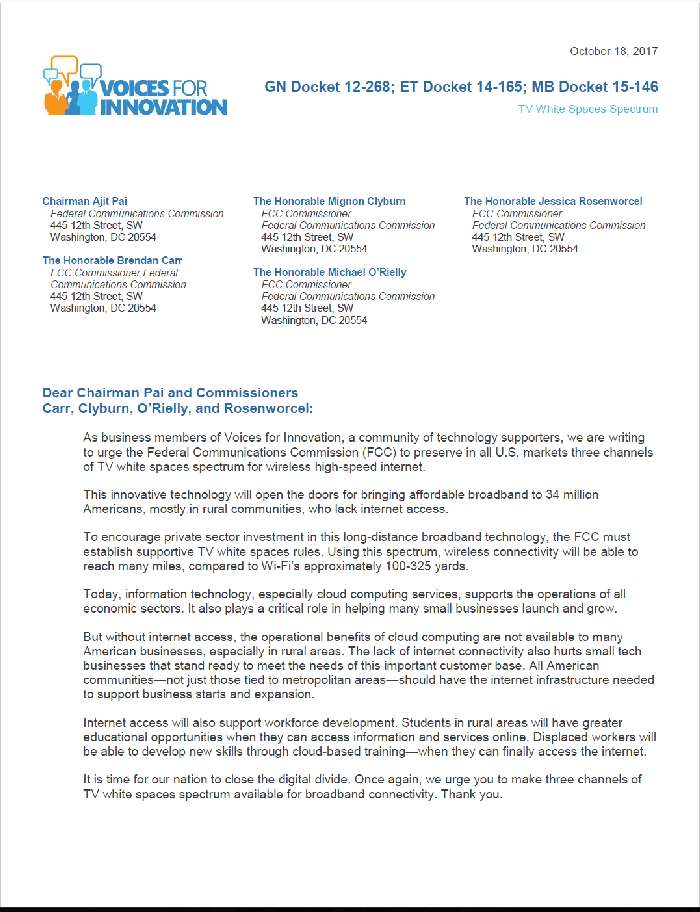
As a Microsoft partner leader of Voices for Innovation, I’ve been working on a public policy effort to support the use of TV white spaces (TVWS) spectrum to deliver broadband connectivity.
Though our nation is a global technology leader, more than 10 percent of the U.S. population lacks reliable and affordable broadband access to the internet. The gap is not being closed by wired, mobile, or satellite service providers.
One solution is to allow the use of TV white spaces spectrum to carry high-speed data. For this to happen, the Federal Communications Commission (FCC) must designate that three spectrum channels be available for TVWS broadband all around the country.
While there is growing bipartisan support for TVWS broadband, some have raised doubts about this technology. Here are key myths and facts about this issue to help clear up misunderstandings.
Myth: TV white spaces technology is untested and may not work.
Fact: While TV white spaces technology continues to be improved, it is proven and has already been deployed in at least 18 nations.
Myth: TV white spaces broadband will interfere with television broadcasts.
Fact: In repeated demonstrations, TV white spaces broadband does not interfere with broadcast television. There has been no reported case of interference to date.
Myth: TV white spaces broadband signals will be blocked by topography and buildings.
Fact: TVWS can enable wireless broadband connectivity for nearly 10 kilometers, traveling over hills and through buildings. By comparison, Wi-Fi can only reach approximately 100-300 meters.
Myth: TV white spaces broadband is too slow. 4G LTE fixed wireless is a better option.
Fact: Emerging TVWS broadband can support download speeds of 50 Mbps or more. Even earlier TVWS technology provides speeds up to 30 Mbps. By comparison, when service is available, data download speeds from the top three U.S. wireless carriers average about 14.4 Mbps. It is also more expensive to bring 4G LTE to rural communities compared to TV white spaces broadband.
Myth: TV white spaces broadband is too expensive to deploy.
Fact: Connecting rural Americans to the internet via TVWS technology will be 80 percent less expensive than bringing fiber to homes and 50 percent less expensive than using fixed wireless technology (4G LTE).
Myth: There is not broad support for using TV white spaces for high-speed broadband.
Fact: VFI and Microsoft are not alone in supporting TVWS broadband. Many other organizations, including TechNet, ACT|The App Association, the American Consumer Institute, and others are supporting the effort. Bipartisan groups of governors and members of Congress have also urged the FCC to allocate TVWS spectrum for broadband.
Myth: If the FCC approves three channels for TVWS, broadcasters will unfairly be denied access to airwaves.
Fact: The FCC is being asked to allocate 18MHz of spectrum for broadband access—three channels of 6MHz each. If the FCC approves the use of 18MHz for broadband, broadcasters would still maintain control of at least 10 times as much spectrum.
Myth: Citizens have to sit on the sidelines, waiting for the FCC to make a decision.
Fact: The FCC takes public input and Congress has a role in the debate. The best way to advance TVWS broadband is to communicate with your members of Congress and urge them to voice their support to the FCC.
***
Jon Rivers is a member of Voices for Innovation’s Advisory Task Force and the president of Marketing Monarchs, a boutique marketing firm serving the Microsoft partner community.



